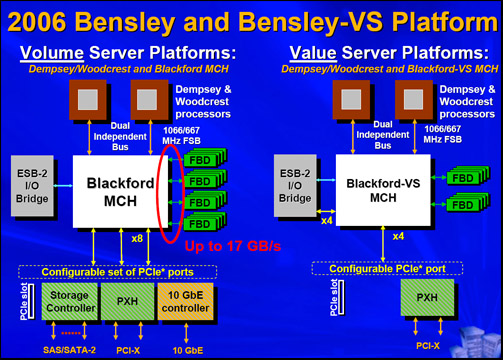Intel’s Dual-Core Xeon First Look
by Jason Clark & Ross Whitehead on December 16, 2005 12:05 AM EST- Posted in
- IT Computing
More processing power has long been the focus of the processor giants, but times are changing. Performance per Watt is the focus for both AMD & Intel for the foreseeable future.
In October of this year, Intel invited AnandTech to its Jones Farm Campus in Portland Oregon. The purpose of the visit was to get a detailed overview of their roadmap for the next year, and to take a close look at the Bensley platform. Bensley is the code name for Intel's new Xeon platform, which will support both Dempsey and Woodcrest processors and a new chipset, code-named Blackford. Demspey is going to take us well into Q2 of next year, and Woodcrest will appear sometime in the second half of next year. Woodcrest will be a lower wattage part that is focused on performance per Watt.
Dempsey is the processor that we're going to take a look at in this article. What we'll be showing benchmarks on is a pre-production Bensley platform. Performance may differ once the platform reaches production status. The key features of Dempsey are: dual-core support, 65nm fabrication and an Independent L2 2MB Cache (2x2MB). Intel will release three variations of the Dempsey processor: a 1066 MHz FSB (130W) version that is the "Performance" version, a 1066 MHz FSB (95W) version that is a rack-optimized part (perf/power for rack density) and a 667 MHz FSB (95W) value version.
The Blackford chipset is all new for Xeon, and addresses one of the main bottlenecks that we've seen in previous Xeon chipsets, front side-bus. Blackford uses a dual independent bus architecture operating at 1066MHz. Memory is now FBD-DDR2 (Fully Buffered DIMM) running at 533MHz, which offers up to 17GB/s of memory bandwidth.
Bensley Platform Diagram
In October of this year, Intel invited AnandTech to its Jones Farm Campus in Portland Oregon. The purpose of the visit was to get a detailed overview of their roadmap for the next year, and to take a close look at the Bensley platform. Bensley is the code name for Intel's new Xeon platform, which will support both Dempsey and Woodcrest processors and a new chipset, code-named Blackford. Demspey is going to take us well into Q2 of next year, and Woodcrest will appear sometime in the second half of next year. Woodcrest will be a lower wattage part that is focused on performance per Watt.
Dempsey is the processor that we're going to take a look at in this article. What we'll be showing benchmarks on is a pre-production Bensley platform. Performance may differ once the platform reaches production status. The key features of Dempsey are: dual-core support, 65nm fabrication and an Independent L2 2MB Cache (2x2MB). Intel will release three variations of the Dempsey processor: a 1066 MHz FSB (130W) version that is the "Performance" version, a 1066 MHz FSB (95W) version that is a rack-optimized part (perf/power for rack density) and a 667 MHz FSB (95W) value version.
The Blackford chipset is all new for Xeon, and addresses one of the main bottlenecks that we've seen in previous Xeon chipsets, front side-bus. Blackford uses a dual independent bus architecture operating at 1066MHz. Memory is now FBD-DDR2 (Fully Buffered DIMM) running at 533MHz, which offers up to 17GB/s of memory bandwidth.
Bensley Platform Diagram











67 Comments
View All Comments
Viditor - Friday, December 16, 2005 - link
LOL...good answer! (especially from coldpower)Viditor - Friday, December 16, 2005 - link
BTW...you do know (I assume) that they don't use heaters in a data center, right? (I figured you did, but thought I'd check just to be sure...)JarredWalton - Friday, December 16, 2005 - link
Not entirely true. They use "environmental regulators" that keep humidity and temperature in a set range. In the winter, the AC portion does less, but the fans are still going full blast. I should know, as I'm sitting here listening to the 75 dB hum of a large regulator right now. :|Viditor - Friday, December 16, 2005 - link
That's my world as well...(TV broadcast equipment is kept under the same conditions...) so you have my condolences. But the point I was trying to get across was that the AC never gets turned off when it's a nice day outside...:)
coldpower27 - Friday, December 16, 2005 - link
Finally if we assume 40 Centers for 1 Year.$587.85 for 365.25 Days for 1 Bensley System.
$23,514 Total to Run 40 Systems for 1 Year.
Poser - Friday, December 16, 2005 - link
In addition to the math being off, the assumption that a datacenter would be paying a similar kW/h rate as a residential customer also seems suspicious. As a major customer, they couldn't negotiate a much better rate?coldpower27 - Friday, December 16, 2005 - link
Watt is Joule/Second isn't though??